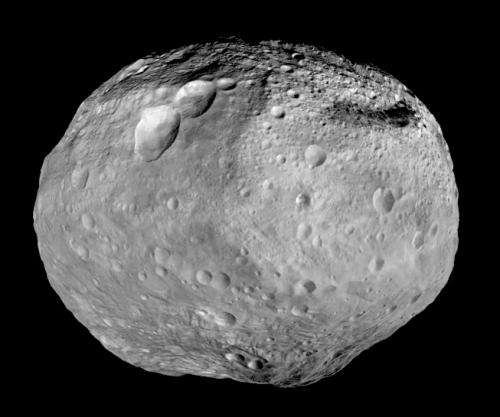Asteroid Vesta. Credit: NASA/JPL-Caltech/UCAL/MPS/DLR/IDA
(Phys.org)—The asteroid Vesta, which exists between Mars and Jupiter, is one of the largest in the solar system—it is also considered to be a protoplanet because it has a core, mantel and crust. Now, a research team made up of members from Switzerland, France and the United States has created 3D computer simulations of the asteroid that appear to explain how it came to be shaped as it is today. As the team describes in their paper published in the journal Nature, it appears Vesta was struck by two massive objects—one approximately 2 billion years ago, and another 1 billion years ago.
Just two years ago, space scientists discovered that not one giant impact, but two had disfigured the southern portion of Vesta. NASA's Dawn spacecraft, which spent a year circling and studying the asteroid, aided this finding; and researchers are now attempting to model Vesta's history.
In an effort to accurately recreate what happened with Vesta, the researchers programmed their simulation to start with the asteroid in a spherical shape. They then rammed it with first one virtual asteroid, then another, using data from the actual asteroid. In so doing, they were able to faithfully recreate the asteroid as it exists today, right down to the spiral structure inside the second impact crater (due, they say, to rotation of the impacting asteroid as it struck). However, the simulation has uncovered one problem—an apparent anomaly—that has researchers arguing among themselves.
Prior research has shown that Vesta's crust should be about 25 miles thick. The computer simulation showed, however, that in order to create craters of the size seen on the asteroid's southern half, the impacting asteroids would have needed to be large enough to knock debris across much of the northern hemisphere, thereby leaving a 60-mile-wide open wound at the point of impact, one that extended through the crust and into the mantle. Furthermore, while the Dawn survey did find evidence of southern crust spewed over the northern hemisphere, it did not find evidence of mantle material in the crater itself (such as the existence of Olivine, a type of rock). This has led some to question the accuracy of the simulation, and others to suggest that estimates of crust depth were wrong and that a new Vesta model is necessary.
Journal information: Nature
© 2013 Phys.org
























